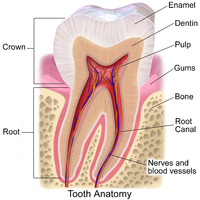
Photo from wikipedia
Abstract Objective: To detect evolution of ultrasonographic signs of deposition of monosodium urate crystals (MSUC) in gouty joints by serial ultrasonography after initiation of urate-lowering therapy (ULT). Methods: Adult gout… Click to show full abstract
Abstract Objective: To detect evolution of ultrasonographic signs of deposition of monosodium urate crystals (MSUC) in gouty joints by serial ultrasonography after initiation of urate-lowering therapy (ULT). Methods: Adult gout patients were examined by serial ultrasonography after initiation of ULT with target serum uric acid (SUA) < 6 mg/dL. Results: Thirty-eight male patients with gout with mean age of 50 ± 11 years, median disease duration of 48 months and baseline mean SUA level of 8.8 ± 1.5 mg/dL were recruited. Ultrasonographic evidence of MSUC deposition was detected in 89.74% of first metatarsophalangeal (MTP) joints and 27.63% of knee joints. Double contour sign (DCS), tophi, and hyperechoic spots (HES) were detected in 77.63%, 43.42%, and 19.74% of first MTPs, respectively. SUA level normalizes and plateaus after fourth month of follow-up. DCS thickness reduced significantly throughout the follow-up period. Overall, 86.25% DCS and 100% HES disappeared with median time of 6 months and 5.7 months, respectively. SUA normalization was the only significant predictor of DCS disappearance. Conclusions: Serial ultrasonographic determination of DCS, tophi, or HES during hypouricemic therapy is a noninvasive, effective method to detect the lowering of burden of urate load in gouty joints.
Journal Title: Modern Rheumatology
Year Published: 2017
Link to full text (if available)
Share on Social Media: Sign Up to like & get
recommendations!